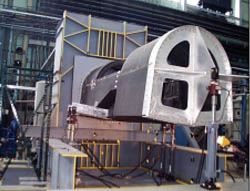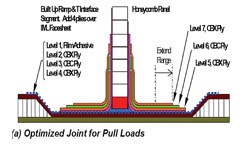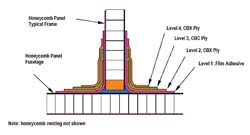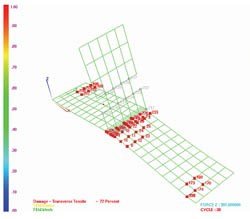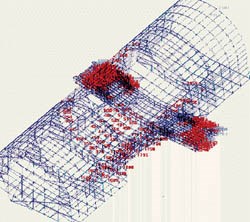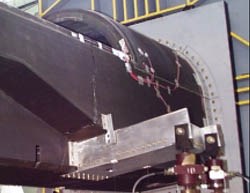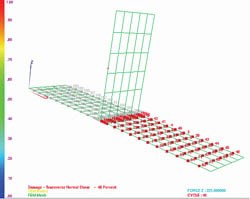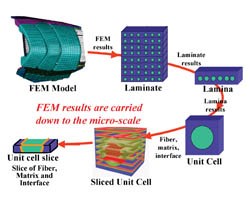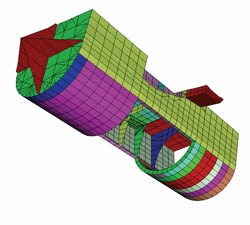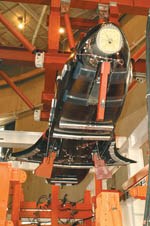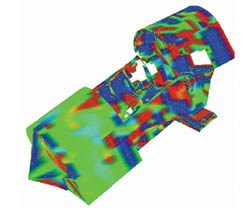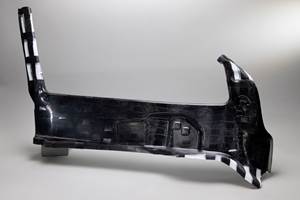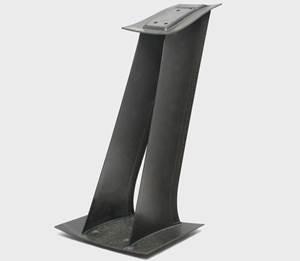GENOA modeling software closely predicts composite structuralfailure
Progressive failure analysis and material-level damage modeling enable life prediction of composite structures.
A variety of structural simulation software programs have proven valuable in recent years by enabling composite component manufacturers to produce highly optimized products in less time and at lower cost compared to more traditional design/build/test development programs. Every year, the accuracy and capabilities of the different simulation programs increases. Among the most accurate and capable is GENOA, introduced by Alpha STAR Corp. (ASC, Long Beach, Calif., U.S.A.). GENOA software simulates the failure process of composite structures under a variety of real-world conditions. The program complements traditional finite element programs and has benefited a number of aerospace programs, including the Advanced Subsonic Technology (AST) Composite Wing Program, the SMV Wing Box and Center Fuselage Demonstration Program, the Airborne Laser Reactor Housing and, more recently, the X-37 Spaceplane.
Approximating the real
Engineers use finite element analysis (FEA) to predict the behavior of structures under different loading conditions. The analyst sets up the problem by defining part geometry, material properties, loads and boundary conditions. The software processes that information and displays the expected structural response as stresses, strains, deflections, vibration frequencies and other parameters. If the predicted response is greater than allowed, material can be added or the geometry modified in order to increase design margins. Conversely, if the predicted margins are large, material can be removed in order to minimize weight.
It is always important to remember, however, that an FEA is an approximation of the real world. Differences between ideal and as-built properties, expected and actual loads, and even numerical rounding will all have an effect on the solution. More importantly, the finite element model (FEM) is essentially just a collection of equations that represent the part behavior. The ultimate accuracy of the solution depends on how well those equations model real-world behavior.
Composite models are typically based on laminated plate theory. This theory provides an accurate prediction of ply stresses and strains, and overall deflections -- assuming, of course, that material and load inputs are reasonably accurate. Determining whether these stresses or strains cause the laminate to fail, however, is a more difficult task. Many failure criteria have been developed, but there is little consensus about which, if any, provides accurate results under a wide range of conditions. The simplest theory, maximum strain (or stress), simply states that a ply fails when a strain (or stress) component exceeds a certain level, determined empirically. Another popular theory, the Tsai-Wu or quadratic criterion, also is based on empirical stress levels, but attempts to account for interaction between the different stress and strain components.
Progressive failure analysis
These traditional failure criteria all have one feature in common: they treat composite plies as homogeneous materials, ignoring the details of fiber and resin. Furthermore, plies are treated as either intact or failed: there is no intermediate state. More rigorous theories, of which there are at least a dozen, recognize that failure is a progressive process: damage initiates and grows near the site of small, sometimes microscopic flaws; the damage may initially grow at a slow, stable rate and then, eventually, at a rapid rate resulting in catastrophic failure. Traditional theories can be used in a progressive fashion, by reducing the properties of failed plies one by one. Ultimately, though, this type of analysis still ignores the microscopic behavior of the laminae. Since these theories involve a fairly high degree of uncertainty, engineers must allow a greater design margin. Furthermore, the assumption of homogeneity limits the theories' utility for long-term durability analyses.
ASC's GENOA has gone a considerable distance toward overcoming such limitations. GENOA is based on NASA's Composite Durability Structural Analysis (CODSTRAN) program, and was developed under a combination of NASA contracts and ASC internal funding, earning NASA's "Best Software of the Year" award in 1999. GENOA is a full-structure, finite element-based life prediction program, capable of predicting failure under a variety of static, dynamic, fatigue and thermomechanical loads. GENOA differs from other life prediction programs, though, both in the way it models materials and in its handling of nonlinear behavior. Structural properties are broken down from the laminate level to the ply level and, finally, to the constituent material micro-scale level. At this basic level, the program can take microscopic defects into account, then rebuild the model back up to laminate properties using a combination of micromechanics and laminate theories. By stepping the applied loads up incrementally, as in a traditional nonlinear analysis, the program can track the spread of damage at microscopic and macroscopic levels, updating local properties at each step.
GENOA tracks 14 different failure criteria, taking into account tensile, compressive and shear stresses in both the fiber and matrix, as well as other failure modes, such as fiber microbuckling and ply separation or delamination. The micromechanics models also recognize the unique nature of three-dimensional composites, and can account for the specific geometry of woven, braided, knitted and stitched composites. Beyond the ideal fiber geometry, GENOA also can account for as-built conditions, including fiber waviness, void content and operational conditions, such as moisture content. GENOA essentially provides a "virtual test" environment, modeling the actual part with all of its built-in flaws under the expected test or in-service conditions.
X-37 reusable spaceplane
The X-37 is being developed by The Boeing Co. (Chicago, Ill., U.S.A.) under a cooperative agreement with NASA and will serve as a test bed for a variety of airframe, propulsion and operation technologies. NASA intends to use these new technologies in its Orbital Space Plane, which will provide rescue and transport services during flights to and from the International Space Station.
The X-37 is an 8.38m/27.5-ft-long unmanned spaceplane with a wingspan of 4.6m/15 ft. Under the program, Boeing is developing two flight vehicles. The first, an Approach and Landing Test Vehicle (ALTV), is to be dropped from a B-52 to test aerodynamic stability, structural integrity and autonomous approach and landing. The second, an Orbital Vehicle, Boeing planned to send into orbit aboard an Atlas V or Delta IV, anticipating that it would remain in orbit for up to nine months to test on-orbit, reentry and landing systems. In December 2003, however, funding problems forced NASA to put the orbital portion of the program on hold. The ALTV is still on track for initial drop tests late this year or in early 2005.
To validate the X-37 structural design, Boeing built the Advanced Technology Demonstrator (ATD-2) and subjected it to a series of structural tests. Prior to and concurrent with the tests, ASC analyzed the structure using the GENOA Progressive Failure Analysis (GENOA-PFA) tool. According to Dr. Jerry Housner, a consulting engineer for ASC, the analyses were used to simulate the original test, predict the spacecraft performance over multiple missions, and identify areas where the design could be improved. The analyses followed a "building block" approach, starting with material verification and proceeding through coupon simulation, sub-element simulation and, finally, full-scale modeling. (For background on the "building block" approach to material qualification, see HPC July/August 1999, p. 20.)
GENOA-PFA
In order for any finite element model to be useful as a design tool, it must accurately predict the response of a structure. Model accuracy is often determined in a structural validation test: the modeled part is built and tested, the test data is compared to the FE prediction, and the FEM is then updated to better match the test results. This process can identify poor assumptions or errors in the original model, making the updated model a better tool for further design changes.
In the case of the ATD-2, an existing NASTRAN model was converted to a GENOA model. (GENOA can read several different finite element formats, and it is common to start with a model from another program.) The NASTRAN model had been used earlier to model the test, so it provided a validated starting point for the GENOA analysis. Once the basic element and nodal schedule were converted -- an easy process -- effort was concentrated on creating the detailed zonal ply schedules, taking into account local changes in layup and as-built conditions. The ply schedules included as-built flaws and voids, as identified by an ultrasonic inspection performed by Boeing's Tulsa division (Tulsa, Okla., U.S.A.), to more accurately model the vehicle behavior. A total of 14 different ply schedules were defined, each with different combinations of tape, fabric, honeycomb core and aluminum.
To validate the new GENOA model, ASC engineers simulated the structural test using the original T300/R976 carbon prepreg system, supplied by Toray Composites America (Tacoma, Wash., U.S.A.). The test article had first been subjected to a symmetrical load condition, followed by an asymmetrical load condition that was cycled to limit (or expected operational) loads, ultimate (or maximum design) loads, and finally failure. Under asymmetrical loading, the GENOA model predicted a failure location on the fuselage bottom surface, near the actual crack observed in the test, and a failure load within 2.1 percent of the test failure load -- 9,616 kg/21,200 lb (test) vs. 9,752 kg/21,500 lb (predicted). The progressive failure analysis ran the load cases in sequence, monitoring the start and propagation of damage and updating the local material properties as needed. Although similar to a conventional nonlinear analysis, GENOA's ability to monitor the damage at the material micro-scale sets it apart from other finite element programs. In this case, GENOA determined that some minor damage occurred during the initial symmetrical load case, and that this damage reduced the ultimate load carrying capability by 45.4 kg/100 lb. Although this was a relatively small reduction for this application, a conventional failure analysis likely would have missed this type of event entirely. Even testing may not have revealed this event: during the symmetrical test, no noises emanating from the test article were heard to indicate damage was occurring. Armed with the GENOA results, however, test engineers may have been more alert to possible low-level damage and may have performed nondestructive inspections between loadings.
More importantly, the ATD-2 test represented only a single load cycle. Over the life of the vehicle, the low-level damage would grow, perhaps reducing the ultimate load by significantly more than 45.4 kg/100 lb. Forewarned that fatigue damage might become a long-term problem, the ASC engineers ran the same analysis using an IM7/5250-4 carbon/BMI prepreg system supplied by Cytec Engineered Materials (Tempe, Ariz., U.S.A.) in place of the T300/R976 carbon prepreg. The toughened carbon/BMI system increased the predicted failure load by over 50 percent: to 18,098 kg/39,900 lb for a tape/fabric construction, and to 17,236 kg/38,000 lb for an all-fabric construction. Although the initial damage load and ultimate load is similar in both IM7/5250 designs, the analysis shows the all-fabric design is better able to redistribute loads after initial damage occurs. Finally, with the increased ultimate loads, the laminate thickness could be reduced, cutting weight while still maintaining improved margins.
Accounting for all variables
GENOA virtual testing allows engineers to examine many different load cases and structural configurations. For example, analysis of the honeycomb T-joint, which joins the internal frame structure to the fuselage body, yields more dramatic results. The initial design had the frame panel meeting the fuselage panel in a "T" configuration, with simple doubler plies bonding the two together. Joint failure was predicted when the fuselage facesheet delaminated, at a load of 67.1 kg/148 lb. The joint was redesigned by removing the fuselage core in the joint area and building up the fuselage laminate, using additional plies of prepreg. Additional doubler plies also were used to bond the frame panel to the fuselage. The new T-joint design failed at a load of 115 kg/254 lb -- a 72 percent increase. Furthermore, the new joint failed at the fillet radius of the doubler plies, making it much more amenable to repair.
While any modern FE program can analyze design details like these, GENOA's ability to model at the constituent material level and perform a progressive failure analysis improves the accuracy of results. In the case of the T-joint, GENOA was able to capture the behavior of ply drop-offs, fillets and transitions. On a more global scale, different material models for fabric and tape plies showed increased damage tolerance with an all-fabric design. The virtual test environment highlights the weakest areas of the structure, so the physical tests can be designed to properly test the predicted failure modes. By accurately predicting crack initiation and growth, impending failure and final failure locations, engineers can better optimize designs, reduce weight and improve margins.
Related Content
Plant tour: Albany Engineered Composites, Rochester, N.H., U.S.
Efficient, high-quality, well-controlled composites manufacturing at volume is the mantra for this 3D weaving specialist.
Read MoreComposite resins price change report
CW’s running summary of resin price change announcements from major material suppliers that serve the composites manufacturing industry.
Read MoreHighly tunable, woven lattice reinforcements target automotive structures
CAMX 2023: Startup Weav3D will be demonstrating its two collaborative automotive demonstrator parts and present two conference papers.
Read More3D weaving capabilities achieve complex shapes, reduce weight and cost
JEC World 2024: Bally Ribbon Mills is displaying film-infused 3D woven joints, woven thermal protection systems (TPS) and woven composite 3D structures.
Read MoreRead Next
Developing bonded composite repair for ships, offshore units
Bureau Veritas and industry partners issue guidelines and pave the way for certification via StrengthBond Offshore project.
Read More“Structured air” TPS safeguards composite structures
Powered by an 85% air/15% pure polyimide aerogel, Blueshift’s novel material system protects structures during transient thermal events from -200°C to beyond 2400°C for rockets, battery boxes and more.
Read MoreAll-recycled, needle-punched nonwoven CFRP slashes carbon footprint of Formula 2 seat
Dallara and Tenowo collaborate to produce a race-ready Formula 2 seat using recycled carbon fiber, reducing CO2 emissions by 97.5% compared to virgin materials.
Read More



